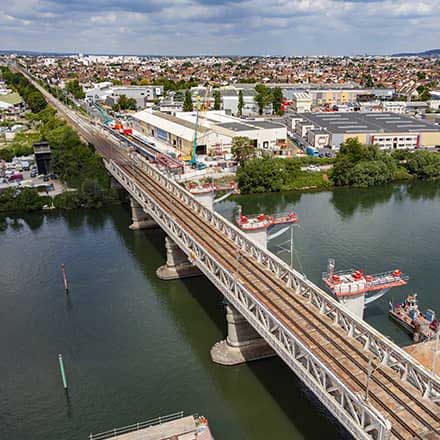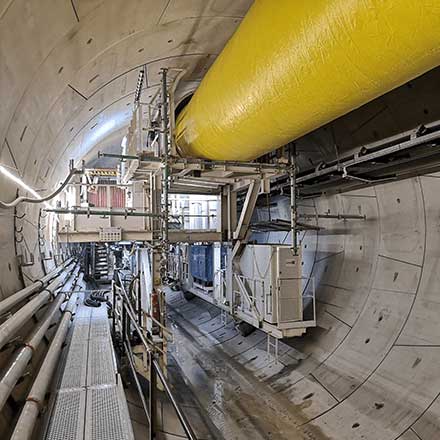Our business sectors at the centre of each project
-
The site personnel manager handles all the human resources administration in order to apply the policies defined by top management. S/he constitutes and updates staff files and is also in charge of regulatory documents, handling requests for contracts in connection with HR, invitations to training with the training department and social security contributions with the payroll department.
The site personnel manager may also be involved in various HR projects like the ones concerning changes in working hours. S/he monitors the development and results of these projects. S/he communicates all the information and social performance indicators required to monitor personnel activity (absenteeism, payroll, holiday, and workplace accidents, etc.)
The site personnel manager is thorough and organized, with good interpersonal and writing skills in the field of staff administration.
Learn more about the job of site personnel manager in pictures on our YouTube channel.
-
The site foreman is involved at each stage of the building project. S/he answers to the works supervisor and ensures the general organization of the worksite on a daily basis.
It is the site foreman's job to make sure the construction work is carried out well. S/he also ensures compliance with guidelines, standards and rules, especially in the field of safety. His/her work is organized around three main activities :
- Site preparation: s/he discovers the technical dossier and plans, takes part in preparatory meetings with the works supervisor and research engineer and supports the works supervisor in his assessment of human and material needs.
- Works organization and monitoring: s/he monitors project progress, materials deliveries and the arrival of works machines, manages the budget, follows up the hours worked and the schedule and checks the order forms and invoices.
- Project completion: s/he takes delivery of the completed work with the works supervisor and makes sure the site is clean and tidy at the end of the project.
The site foreman must complete the project to schedule, solve technical and human problems fast, deal with bad weather and be able to cope with unexpected events.
S/he is practical and able to manage people. S/he must enjoy responsibility and be able to take the initiative to ensure the smooth running of the project.
Learn more about the job of site foreman in pictures on our YouTube channel.
-
The civil engineering formworker is the basic worker on major building projects and the construction of prefabricated elements.
S/he works on both major infrastructure and one-off project building sites. The formworker's tasks are not repetitive since each structure is different. S/he thus needs to have good adaptation capacities.
The formworker carries out four main operations:
- S/he builds the formwork, or the mould into which concrete is poured
- S/he places the steel reinforcement frame inside the mould to reinforce the concrete
- S/he pours the concrete into the mould
- S/he removes or strips the piece. This is a delicate operation as the concrete must be kept intact without damaging the formwork.
The formworker understands structural layout and installation, and can assemble and dismantle scaffolding and shoring equipment, construct and fit timber formwork, install and remove formwork panels, build reinforced concrete structures and the prefabricated components required for them, use small machines safely and monitor compliance and building quality. S/he has good manual skills and a good eye, is conscientious and enjoys taking the initiative.
Learn more about the job of formworker in pictures on our YouTube channel.
-
The works supervisor is responsible for the operational co-ordination of one or several worksites.
- S/he manages and organizes the site, constitutes the teams which are supervised by the site foreman, monitors work in progress, buys and distributes materials and checks the site reports drafted by the site foremen.
- S/he meets clients and guarantees top-quality construction work and the application of methods and safe practices.
- The works supervisor must have up-to-date knowledge of technical developments. S/he attends the first technical and pricing study meetings and prepares the worksite according to the estimated budget.
S/he supervises site reconnaissance and the complex administrative procedures involved in the opening of a worksite and selects the human and material resources required to carry through the building project. S/he schedules tasks and project progress and is responsible for the quality assurance plan. S/he is the company's representative on the site and must make sure that the work in progress is compliant with plans and budget and remains cost-effective.
The works supervisor also plays a commercial role in customer care and retention and the search for new clients and markets and is thus a true entrepreneur.
Learn more about the job of works supervisor in pictures on our YouTube channel.
-
The draughtsman designs the plans used at each stage of a building project. More specifically, s/he is involved in technical research for the preliminary designs, drafting operating documents and monitoring work in progress.
The draughtsman chiefly works in a design and engineering department. S/he is required to represent the different stages of building in plan form, according to the engineer's instructions. These theoretical plans are not fixed and may need correcting in order to adjust them to construction site reality.
The draughtsman may carry out different tasks in the design and engineering department, corresponding to his/her training and experience:
- Engineering office draughtsman, in charge of drawing up detailed project plans,
- Qualified design draughtsman, responsible for studying the challenges involved in building certain parts of the structure.
On the worksite, s/he is the technical drawing consultant who guarantees the quality of the output supplied. S/he regularly comes in to support and advise the works teams throughout the project.
S/he is thorough and well-organized, and skilled in using the various types of design software required to draw up technical plans. S/he is a good communicator, interacting with the different internal actors (works supervisors and surveyors) and external players (client, architect).
Learn more about the job of draughtsman in pictures on our YouTube channel.
-
The electrician installs and commissions electrical equipment. In the civil engineering field, electricians essentially work outside on life-sized structures and more specifically, on high-voltage power lines. They use plans to decide where to place the different electrical installation components, then go on to lay cables and wires, fit electrical cabinets and power outlets and connect up the facility with the external network. S/he also ensures the system is compliant with safety standards and carries out the necessary updating work.
On major projects, the electrician refers to installation diagrams and plans drawn up by the design and engineering department technicians. After commissioning, s/he is usually in charge of maintenance.
Electricians tend to work on major building or renovation worksites under the guidance of their team and works foremen.
Electricians must be methodical, careful, organized and vigilant at all times since mistakes can have a serious impact on facility safety.
Learn more about the job of electrician in pictures on our YouTube channel.
-
The crane operator is a worksite expert, highly qualified in operating and manoeuvring lifting equipment.
S/he supplies the different parts of the site with material and must handle the machine from beginning to end. S/he checks the security systems and loading weight before starting up the machine and is responsible for its daily maintenance. S/he adjusts to team activity requirements and may have to anticipate instructions in order to improve team performance. The crane operator's role is essential to project site operations.
Two kinds of crane operator may exist on a site:
- The tower crane operator remains on the same site throughout the works period, communicating with the team foremen by radio. S/he may have to move materials with zero visibility and take part in assembling and dismantling the crane.
- The mobile crane operator must adjust to new environments (operation location, person in charge of the manoeuvre, load type) on a regular basis. S/he analyses site specificity, adjusts individual protection equipment, stabilizes the crane according to terrain type and ensures the load is correctly hooked up.
The crane operator is attentive and calm with excellent spatial representation capacities and manual dexterity. S/he is able to make the decisions needed for safe, quick and efficient action.
Learn more about the job of crane operator in pictures on our YouTube channel.
-
The cost estimation engineer is responsible for all or part of the financial estimation of a project. Her/his principal task is to analyse the financial means required for a building project. To carry through this assignment, the cost estimation engineer analyses the contractual documents associated with the pro ject.
This technical assessment enables her/him to define the methods, construction aspects and estimated works schedule. As cost-effectiveness is an ongoing concern, s/he must calculate the cost of the works, human resources, and materials needed for the success of the project.
S/he writes quotes and negotiates prices with suppliers, with the help of specialists (buyers and methods, technical and structural engineers).
The cost estimation engineer has to monitor project progress, in order to review and readjust the various costs if necessary.
Under the guidance of a project manager or cost estimation office manager, s/he is in charge of drafting all the technical documents involved in the project (technical and commercial proposal and implementation schedule). The cost estimation engineer is thorough, with good negotiating skills and excellent project planning capacities.
-
The methods engineer is in charge of identifying and studying ways of improving the company's processes so as to optimize production and increase efficiency, gain and quality. S/he is involved during the research and study phase and during construction, under the guidance of a project manager or production engineering office manager. S/he aims to optimize the company's cost-effectiveness and efficiency by studying the existing situation or by using calculations, in order to propose solutions concerning the number of machines and employees, process organization, working methods, subcontracting etc.
- During the RFT response phase: the methods engineer defines the various implementation options and variants with the cost estimation office and sales teams.
- At the pre-works stage: s/he prepares the worksite installation plans, schedules and operating modes and identifies human and material requirements by capitalizing on previous experience.
- During construction: the methods engineer monitors operations and supports the works teams with his/her skills and knowledge.
The works engineer is organized, has good analytical skills, and is a driving force for new ideas. S/he also has some educational competence.
Learn more about the job of methods engineer in pictures on our YouTube channel.
-
The surveying engineer determines the limits of the land and its physical and legal suitability for development. S/he is the first player involved in neighbourhood development projects and road layouts before the start of the works, carrying out field surveys with the help of a specialized device called a theodolite, where no detail is overlooked: altitude, trees, telegraph poles, walls, etc. On the basis of these surveys, s/he draws up plans and maps on computer, using quantity surveying software, computer-aided drawing, geographic information systems, satellite imagery, etc.
On a daily basis, the surveying engineer handles the layout implantation expected by the site foreman and project manager before the start of the project (natural ground surveys) during the works and after completion (as-built specifications).
S/he must be thorough and observant, with a sense of space and three-dimensional drawing skills, and be at ease with computerized data processing.
S/he must also be trained in topography and land law.
The surveying engineer often works in a two-person team with a rodman (or woman).
Learn more about the job of surveying engineer in pictures on our YouTube channel.
-
The mechanic is in charge of the maintenance and repair of the mechanical and hydraulic parts of site machines such as cranes, hydraulic excavators, lorries, concrete mixing plants and multi-purpose vehicles.
The equipment and techniques used on the sites are constantly developing, making the job both interesting and difficult. The hydraulics mechanic works on various kinds of machine and needs to have the necessary hydraulics, pneumatics, electricity and onboard electronics skills to be able to adjust quickly to any type of site. For this reason, the job requires a high degree of autonomy enabling the mechanic to adapt to machines which use different technologies.
The mechanic is calm, organized, imaginative and skillful, and tries to overcome difficulties encountered.
Learn more about the job of mechanic in pictures on our YouTube channel.
-
The TBM operator carries out underground work such as excavation and support via traditional methods or with a TBM.
S/he builds and renovates underground tunnels (for railways, motorways and sanitation networks). S/he undertakes manual and/or mechanical boring work to enable the construction of adits, wells and tunnels and carries out underground operations and earthworks on civil engineering projects.
S/he takes charge of extraction and support works, ensuring that rubble and debris are correctly evacuated. S/he works in a confined environment as part of a team, assisted by a crane.
The TBM operator carries out underground works according to one of two methods, according to project size and ground characteristics.
- Using traditional methods, he sinks the well, constructs and assembles support frames, excavates and digs wells and adits and carries up rubble with the help of cranes and skips, while progressively shielding the tunnel as work progresses.
- With the help of a TBM he uses an erector, takes part in installing lining segments (supply) carries out annular void filling operations with mortar and takes part in laying rails.
Strict compliance with rules and safety instructions is necessary at all times, given the kind of operations undertaken and the environmental characteristics (dust, temperature, gas).
The TBM operator is methodical and rigorous, carrying out these various works according to the regulations in force.
-
The TBM pilot/driver controls the TBM's path and direction and is responsible for tunnel boring progress. S/he continually monitors work in progress via the on-screen guidance system. The steering cabin allows the pilot/driver to adjust the machine and follow the intended layout.
The TBM pilot/driver works with a team of electricians, control engineers, hydraulics mechanics and surveyors and must be attentive to both other underground actors and those above ground. S/he must be able to assess a number of mechanical and civil engineering parameters and take terrain geology into account.
The pilot/driver must know how to handle stress and identify TBM incidents and breakdowns. S/he is at the hub of TBM communication and must be able to receive information and transmit it accurately to the right actor. S/he must also be careful, thorough and vigilant; the success of the project depends on her/his gestures and decisions.
Learn more about the job of TBM pilot/driver in pictures on our YouTube channel.
Consult our job offers
Eiffage Génie Civil offers a wide range of professions working on exciting and challenging projects such as the Greater Paris project. By joining our teams, you'll benefit from real career opportunities.



